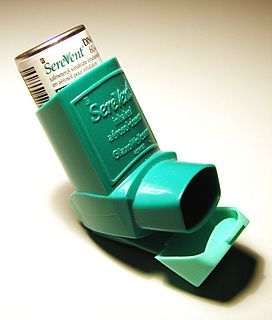
Epilepsy is a group of non-communicable neurological disorders characterized by recurrent epileptic seizures. Epileptic seizures can vary from brief and nearly undetectable periods to long periods of vigorous shaking due to abnormal electrical activity in the brain. These episodes can result in physical injuries, either directly such as broken bones or through causing accidents. In epilepsy, seizures tend to recur and may have no immediate underlying cause. Isolated seizures that are provoked by a specific cause such as poisoning are not deemed to represent epilepsy. People with epilepsy may be treated differently in various areas of the world and experience varying degrees of social stigma due to their condition.

Hypnotic, or soporific drugs, commonly known as sleeping pills, are a class of psychoactive drugs whose primary function is to induce sleep and to treat insomnia (sleeplessness),

Intravenous therapy is a medical technique that delivers fluids, medications and nutrition directly into a person's vein. The intravenous route of administration is commonly used for rehydration or to provide nutrition for those who cannot, or will not - due to reduced mental states or otherwise - consume food or water by mouth. It may also be used to administer medications or other medical therapy such as blood products or electrolytes to correct electrolyte imbalances. Attempts at providing intravenous therapy have been recorded as early as the 1400s, but the practice did not become widespread until the 1900s after the development of techniques for safe, effective use.
Schizoaffective disorder is a mental disorder characterized by abnormal thought processes and an unstable mood. The diagnosis is made when the person has symptoms of both schizophrenia and a mood disorder—either bipolar disorder or depression. The main criterion for a diagnosis of schizoaffective disorder is the presence of psychotic symptoms for at least two weeks without any mood symptoms present. Schizoaffective disorder can often be misdiagnosed when the correct diagnosis may be psychotic depression, psychotic bipolar disorder, schizophreniform disorder, or schizophrenia. It is imperative for providers to accurately diagnose patients, as treatment and prognosis differs greatly for each of these diagnoses.

Pharmacy is the clinical health science that links medical science with chemistry and it is charged with the discovery, production, disposal, safe and effective use, and control of medications and drugs. The practice of pharmacy requires excellent knowledge of drugs, their mechanism of action, side effects, interactions, mobility and toxicity. At the same time, it requires knowledge of treatment and understanding of the pathological process. Some specialties of pharmacists, such as that of clinical pharmacists, require other skills, e.g. knowledge about the acquisition and evaluation of physical and laboratory data.

A deoxyribonuclease is an enzyme that catalyzes the hydrolytic cleavage of phosphodiester linkages in the DNA backbone, thus degrading DNA. Deoxyribonucleases are one type of nuclease, a generic term for enzymes capable of hydrolyzing phosphodiester bonds that link nucleotides. A wide variety of deoxyribonucleases are known, which differ in their substrate specificities, chemical mechanisms, and biological functions.

Naproxen, sold under the brand name Aleve among others, is a nonsteroidal anti-inflammatory drug (NSAID) used to treat pain, menstrual cramps, inflammatory diseases such as rheumatoid arthritis, gout and fever. It is taken orally. It is available in immediate and delayed release formulations. Onset of effects is within an hour and last for up to twelve hours.
Postoperative nausea and vomiting (PONV) is the phenomenon of nausea, vomiting, or retching experienced by a patient in the postanesthesia care unit (PACU) or within 24 hours following a surgical procedure. PONV affects about 10% of the population undergoing general anaesthesia each year. PONV can be unpleasant and lead to a delay in mobilization and food, fluid, and medication intake following surgery.

Tinea barbae is a fungal infection of the hair. Tinea barbae is due to a dermatophytic infection around the bearded area of men. Generally, the infection occurs as a follicular inflammation, or as a cutaneous granulomatous lesion, i.e. a chronic inflammatory reaction. It is one of the causes of folliculitis. It is most common among agricultural workers, as the transmission is more common from animal-to-human than human-to-human. The most common causes are Trichophyton mentagrophytes and T. verrucosum.

Sulfasalazine (SSZ), sold under the trade name Azulfidine among others, is a medication used to treat rheumatoid arthritis, ulcerative colitis, and Crohn's disease. It is considered by some to be a first-line treatment in rheumatoid arthritis. It is taken by mouth.

An inhaler is a medical device used for delivering medicines into the lungs through the work of a person's breathing. This allows medicines to be delivered to and absorbed in the lungs, which provides the ability for targeted medical treatment to this specific region of the body, as well as a reduction in the side effects of oral medications. There are a wide variety of inhalers, and they are commonly used to treat numerous medical conditions with asthma and chronic obstructive pulmonary disease (COPD) being among the most notable.

Wristbands are encircling strips worn on the wrist or lower forearm. The term can be used to refer to a bracelet-like band, similar to that of a wristwatch, to the cuff or other part of a sleeve that covers the wrist, or decorative or functional bands worn on the wrist for many different reasons. Wristbands are often worn and used similarly to event passes such as lanyards to information or allow people entry to events. These wristbands are made from loops of plastic that are placed around the wrist and are used for identification purposes.

Bullous pemphigoid is an autoimmune pruritic skin disease preferentially in older people, aged over 60, that may involve the formation of blisters (bullae) in the space between the epidermal and dermal skin layers. The disorder is a type of pemphigoid. It is classified as a type II hypersensitivity reaction, with the formation of anti-hemidesmosome antibodies.

Tizanidine, sold under the brand name Zanaflex among others, is a medication that is used to treat muscle spasticity due to spinal cord injury or multiple sclerosis. Effectiveness appears similar to baclofen or diazepam. It is taken by mouth.

A metered-dose inhaler (MDI) is a device that delivers a specific amount of medication to the lungs, in the form of a short burst of aerosolized medicine that is usually self-administered by the patient via inhalation. It is the most commonly used delivery system for treating asthma, chronic obstructive pulmonary disease (COPD) and other respiratory diseases. The medication in a metered dose inhaler is most commonly a bronchodilator, corticosteroid or a combination of both for the treatment of asthma and COPD. Other medications less commonly used but also administered by MDI are mast cell stabilizers, such as cromoglicate or nedocromil.
A growing body of research has begun to highlight differences in the way racial and ethnic groups respond to psychiatric medication.
Arthrocentesis, or joint aspiration, is the clinical procedure performed to diagnose and, in some cases, treat musculoskeletal conditions. The procedure entails using a syringe to collect synovial fluid from or inject medication into the joint capsule. Laboratory analysis of synovial fluid can further help characterize the diseased joint and distinguish between gout, arthritis, and synovial infections such as septic arthritis.

BWI Airport station is a Baltimore Light Rail station at the Baltimore-Washington International Airport in Maryland. It is one of the two southern terminals of the Baltimore Light Rail. The station platforms are just outside an entrance to the International Concourse on the lower level.

Vitreous hemorrhage is the extravasation, or leakage, of blood into the areas in and around the vitreous humor of the eye. The vitreous humor is the clear gel that fills the space between the lens and the retina of the eye. A variety of conditions can result in blood leaking into the vitreous humor, which can cause impaired vision, floaters, and photopsia.
Drug recycling, also referred to as medication redispensing or medication re-use, is the idea that health care organizations or patients with unused drugs can transfer them in a safe and appropriate way to another patient in need. The purpose of such a program is reducing medication waste, thereby saving healthcare costs, enlarging medications’ availability and alleviating the environmental burden of medication.
The debate
Despite the need for waste-preventive measures, the debate of drug recycling programs is ongoing. It is traditional to expect that consumers get prescription drugs from a pharmacy and that the pharmacy got their drugs from a trusted source, such as manufacturer or wholesaler. In a drug recycling program, consumers would access drugs through a less standardized supply chain. Consequently, concerns of the quality of the recycled drugs arise. However, in a regulated process, monitored by specialized pharmacies or medical organization, these uncertainties can be overcome. For example, monitoring the storage conditions, including temperature, light, humidity and agitation of medication, can contribute to regulation of the quality of recycled drugs. For this purpose, pharmaceutical packaging could be upgraded with sensing technologies, that can also be designed to detect counterfeits. Such packaging requires an initial investment, but this can be compensated with potential cost savings obtained by a drug recycling program. Accordingly, drugs recycling seems economically viable for expensive drugs, such as HIV post-exposure prophylaxis medication.
Donating practices
In some countries, drug recycling programs operate successfully by donating unused drugs to the less fortunate. In the United States drug recycling programs exist locally. As of 2010, Canada had fewer drug recycling programs than the United States. These programs occur in specific pharmacies only, since these pharmacies are prepared to address the special requirements of participating in a recycling program. Usually, drug returns happen without financial compensation. In Greece, the organization GIVMED operates in drug recycling, and saved over half a million euros by recycling almost 60k drug packages since 2016. However, in other countries, such as Canada, implementation of drug recycling programs is limited. Other initiatives focus on donating drugs to third world countries. However, this is accompanied with ethical constraints due to uncertainties in quality, as well as practical constraints, due to making the drugs only temporarily available and not necessarily addressing local needs. The World Health Organization provided guidelines on appropriate drug donation, thereby discouraging donation practices that do not consider recipient’s needs, government policies, effective coordination or quality standards.
Towards redispensing as standard of care
Alternatively, drug recycling programs could be set as routine clinical practice with the aim of reducing the economic and environmental burden of medication waste. Still, for general implementation of drug recycling programs, clear professional guidelines are required. Research could provide the rationale for these guidelines. For example, research showed that a majority of patients is willing to use recycled drugs if the quality is maintained, and explored requirements for a drug recycling program perceived by stakeholders, including the general public, pharmacists. and policy-makers. One can assume that implementing drug recycling as routine clinical practice is only attractive from an economical perspective, if the savings exceed the operational pharmacy costs. For this purpose, research should assess the feasibility of drug recycling. In the Netherlands, redispensing of unused oral anticancer drugs is currently tested in routine clinical practice to determined cost-savings of a quality-controlled process. This data could help policy-makers to prioritize drug recycling on their agenda, thereby facilitating guidelines for general implementation of drug recycling.















